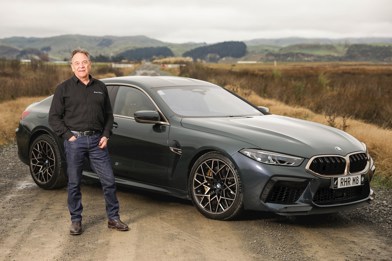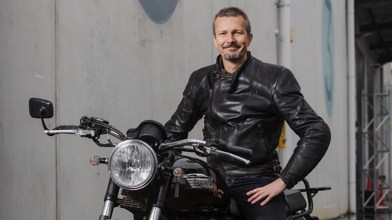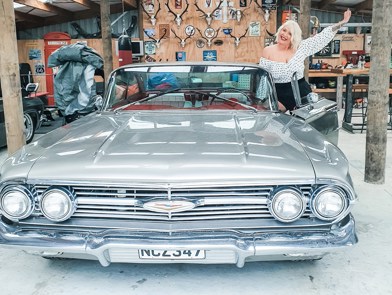The Royal Enfield Himalayan has an interesting backstory. Named for the brand’s spiritual homeland, it was originally developed as an Indian market exclusive. But when the world saw it on its debut in 2016, the bike was flung into the global spotlight as an affordable entry into the highly competitive adventure motorcycle market. It was an accidental overnight success for Royal Enfield, and quickly saw updates to give it more credibility outside its home market.
However, having never been planned as a global market phenomenon, the original Himalayan 411 had its drawbacks. Its basic design with an air-cooled engine and 5-speed gearbox kept the bike humbly down to earth, but it quickly saw the introduction of EFI and switchable ABS braking to bring it closer to the global market’s standards.
The new Himalayan 450, which is expected to arrive in Kiwi dealers early in this year and is priced from a low $8,990, has been developed from day one as a global market machine and it shows. From its build quality to the choice of components, the new Himalayan is a quantum leap forward for the Royal Enfield brand as a whole.
With primary development starting at Royal Enfield’s Tech Centre in the UK, the new bike breaks the mould for the brand in a number of ways. It debuts an all-new engine in the Sherpa 450, which employs water-cooling and a sixth gear for the company for the first time, while the build quality and tech are all aimed at global riders who want a machine that can confidently take them anywhere.
The Sherpa 450 engine is a leap forward for the brand. With its water-cooled DOHC design, aluminium cylinder, DLC coatings on critical components and slick 6-speed gearbox the new engine puts down a respectable 29.4kW and 40Nm of peak grunt.
That is a huge 65% increase in outright power and 25% more torque than the first-generation Himalayan and just shy of the figures achieved by the brand’s 650cc twin cylinder.
The engine’s power feels good, however, riding above 10,000ft meant that we only got to experience 2/3rds of the Sherpa 450’s potential due to the losses experienced by the reduced oxygen at such altitude.
Styling has evolved the classic utilitarian cues of the original Himalayan, with a larger 17-litre fuel tank sitting proudly atop the new engine. Fuel range is now claimed to be roughly 450km, more than enough for an adventure!
The factory crash bars also remain a standard feature but lighting has all switched to LED units. The rear lighting is unique for the segment, with the brake and indicator lights integrated to allow even better wheel travel for the rear wheel.
Suspension duties are now performed by a 43mm Showa upside-down fork and a monoshock with preload adjustment at the rear. The suspension is surprisingly well planted, with the front end, in particular, feeling great amongst the twists and turns of the Himalayan mountain roads and on rocky dirt sections.
Suspension travel is listed as 200mm at both ends, while ground clearance is a useful 230mm which we found to be plenty even when bouncing off rocky riverbeds above 10,500ft during the launch ride.
Keeping the bike accessible for the masses is an adjustable seat height as standard that can move between 825mm and 845mm. Royal Enfield also has two optional seats, a low seat which moves between 805mm and 825mm along with a taller single-piece Rally seat which is part of the Rally Accessories package.
At launch, Royal Enfield already has 30 official accessories for the new Himalayan available ranging from touring essentials to crash protection and everything in between. The Rally accessory kit, in particular, not only looks fantastic but also moves the Himalayan into an even more off-road capable machine.
Tech-wise, the new Himalayan debuts the new TFT Tripper dash which controls multiple rider modes, phone connectivity, switchable ABS, and integrates Google Maps navigation. At 4-inches round, it isn't an overly massive display, but the team put in a lot of effort to ensure that everything you need to know is easily found with just a glance at the dash.
According to the team behind the Tripper Dash, they went through 12 iterations before the final design was confirmed. It works well, and perhaps the smartest thing about it is that it can be updated over time via the Wifi connection - essentially future-proofing the dash for years to come.
It all comes together in a tight package, and it produced plenty of smiles on the launch when we weren’t picking our jaws up off the ground from the utterly stunning scenery.
Is the new Himalayan the bike many seasoned adventure riders have been asking for? No, it's something much better. It’s a bike that is as fun as it is accessible, tough as it looks and is well put together by a team passionate about the motorcycles they produce.
It’s not the adventure rider’s unicorn bike. It's a Himalayan through and through. That’s an honest machine built to do the job without the excess flash, and the world needs more honest motorbikes like it.
PRICE: from $8,990 ENGINE: 451.6cc Liquid-Cooled DOHC single-cylinder POWER: 29.4kW @ 8000rpm / 40Nm @ 5500rpm PROS: Modern amenities, great chassis, and accessible design make ADV riding easy CONS: Still a heavyweight in its class at 198kg.














